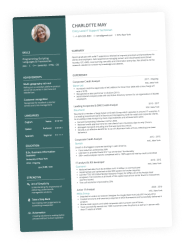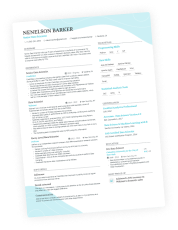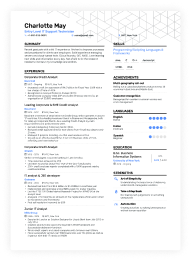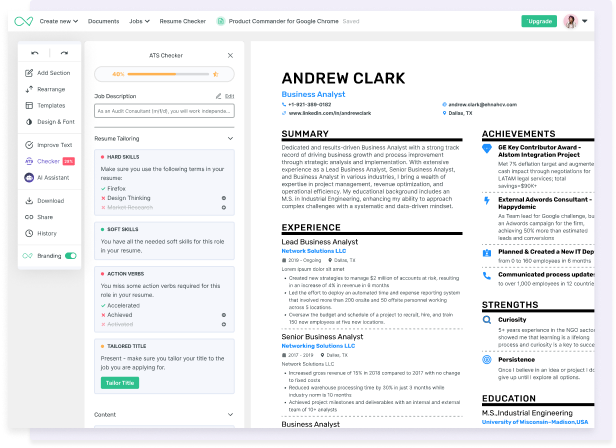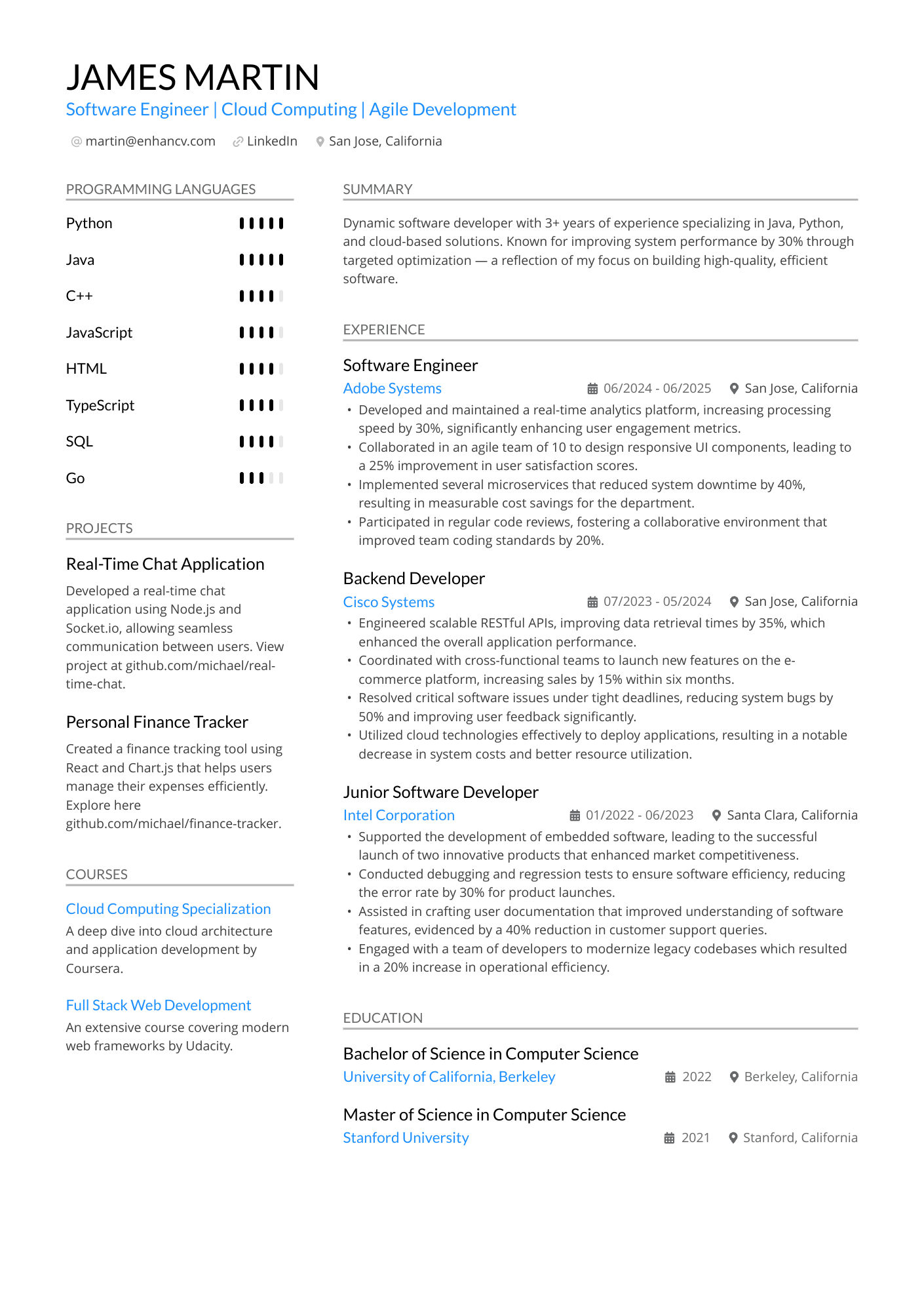A great resume doesn’t just list what you’ve done—it helps employers see what you’re capable of. But too often, strong candidates get skipped because their resume doesn’t communicate clearly or confidently enough.
This guide is about small, effective tweaks that make a real difference—whether you're applying through a job board, reaching out directly, or updating after years in the same role.
No gimmicks, no over-promising. Just practical hacks that help your experience shine through. We’ll cover what works today, where most applicants go wrong, and how to fix your resume fast.
Key takeaways
- Small tweaks matter: From layout to phrasing, small changes can dramatically improve how your resume performs with both recruiters and ATS.
- Tailoring is non-negotiable: Generic resumes get skipped. A master resume you can adjust quickly is the best way to stay relevant.
- Focus on impact, not activity: Measurable results, not task lists, are what make you stand out.
- Your resume is for a human first: ATS is important, but it’s a person who decides to call you. Make it readable, clear, and honest.
- AI helps, but your voice matters: Use AI to enhance—not replace—your resume. Let it help you say things better, not say them for you.
The foundation hack: Optimize for ATS
Most companies use applicant tracking systems (ATS) to sort and manage incoming applications. Many modern systems can also parse and score resumes based on how well they match the job description—though not all do.
Either way, both ATS and recruiters are looking for the same thing: a resume that's easy to read and aligned with the role. That means clear formatting and relevant keywords matter.
ATS-friendly resume hacks that take minutes
- Use exact job title keywords: Mirror the language from the job posting. If the role is listed as “Operations Manager,” don’t write “Head of Ops.” Titles and phrasing show both systems and people that you’ve read the description carefully and understand what they’re looking for.
- Remove images, charts, and text boxes: ATS software often can’t read graphics, especially when text is embedded inside them. Stick to clean, text-based content that’s easy to parse.
- Stick to plain-text formatting: Use standard fonts like Arial or Rubik, left-align your text, and keep formatting consistent. The simpler your layout, the more the focus stays on the content, which is exactly what both recruiters and machines are scanning for.
- Save and submit as a PDF, unless told otherwise: PDF preserves your formatting across devices and software. Most modern ATS can parse PDFs just fine. Only use Word if the application explicitly requests it.
Improving your resume for AI is about removing what gets in the way. Simplify the formatting, use the right words, and let your experience speak for itself.
Enhancv’s free Resume Checker gives you a clear, credible look at how your document might perform in a real applicant tracking system. Run your resume through it in seconds and fix what’s holding you back.
Is your resume good enough?
Drop your resume here or choose a file. PDF & DOCX only. Max 2MB file size.
The show-impact hack: Use power verbs and metrics
A resume isn’t just a list of what you did—it’s a chance to show the impact of your work. You don’t need big, dramatic numbers. But you do need to communicate outcomes, not just tasks.
One of the fastest ways to level up your resume is by pairing strong action verbs with clear, measurable results. It’s a small shift in language that can change how recruiters see your experience.
Resume hacks for quantifying your achievements
- Swap passive phrases for action verbs: Instead of saying “Responsible for managing a team,” say “Led a team of five.” Verbs like led, built, launched, improved, or streamlined give your experience clarity and momentum.
- Add numbers and results: Even a rough number adds credibility. For example, “Increased email open rates by 18%” or “Reduced processing time by 3 hours per week.”
- Use the STAR method to shape stronger bullets: When you're stuck, use Situation - Task - Action - Result as a framework. Even if you don’t include every step, it’ll help you write bullets that focus on the outcome, not just the activity.
- Focus on successes, not just duties: Ask yourself, “What did I accomplish through my actions?” You want the reader to see both effort and value.
PRO TIP
If writing about your experience feels overwhelming, try Enhancv’s Bullet Point Generator. It helps you turn your role, skills, and achievements into clean, outcome-driven bullet points, without sounding robotic. A great way to get unstuck and write entries that actually say something relevant.
The relevance hack: Tailor for each role with a master template
You don’t need to rewrite your entire resume every time, but you do need to tailor it. Recruiters can always tell when a resume feels generic. A well-structured master resume helps you stay efficient while quickly adapting to each role.
Tailoring is about making your most relevant skills and experience easier to see.
Hacks for tailoring your resume effectively
- Start with a master resume template: Keep a single, comprehensive version of your resume with all your roles, bullets, and competencies. From there, create focused versions for each application by pulling only what fits the role. (Using a resume builder like Enhancv streamlines this process for you.)
- Aim to match language: Enhancv’s resume tailoring functionality can show how well your resume aligns with a specific posting. It helps you highlight missing keywords and prioritize what to adjust.
- Mirror the job post: Look at how the job description phrases responsibilities and required skills. Align your language where it makes sense—especially in your summary, job titles, and bullet points.
Here’s a quick glimpse inside Enhancv’s app—this screenshot shows how AI tailors and polishes your resume fast.
The focus hack: Feature the right skills—not all skills
Your skills section is a signal. A well-curated list helps both recruiters and ATS quickly understand where you bring value. Including too many skills (especially outdated or irrelevant ones) can dilute the message. Instead, focus on what’s current, relevant, and specific to the role or industry you’re targeting.
Hacks for choosing the right skills for your resume
- Limit soft skills—show them instead: Instead of listing buzzwords like “team player,” show it in your experience section. Save the skills list for hard skills that actually get scanned by ATS (think in terms of technical abilities, industry know-how, or software, not “strong communicator”).
- Borrow from the job description: Don’t guess what to include—scan the job ad and pull the exact skill terms they mention. If it says “data visualization,” don’t write “dashboards.” Use the same phrasing where it fits.
- Check what’s trending in your industry: Run a quick search of similar roles to spot popular tools and frameworks. If a tool shows up in multiple listings, that’s your cue to include it (assuming you’ve used it).
- Ditch anything outdated or irrelevant: If a skill won’t help you get this job, cut it. No one’s hiring because you know Microsoft FrontPage.
The readability hack: Format your resume like a pro
You don’t need a design background to make your resume look professional. In fact, simple, well-structured resumes usually perform better. They’re easier to read, easier to scan, and less likely to break inside ATS software. Formatting is less about visuals and more about clarity.
Below are a few resume tips and tricks that simplify the process—for both you and the hiring manager.
Formatting hacks to enhance readability
- Organize your resume so it fits your story: Reverse-chronological format works best for most roles and is usually the safest choice. Functional resumes are ideal for career changers or anyone with gaps—they spotlight transferable skills. Hybrid (or combination) formats give you room to highlight both skills and experience, side by side.
- Use white space to guide the eye: Cluttered resumes are hard to scan. Add breathing room between sections and keep your margins consistent. It’s one of the fastest ways to make your resume feel more polished.
- Keep fonts and headings clean: Stick to one font (two max), and make sure your section headings are clear and easy to scan. Use familiar, readable fonts like Calibri, Arial, or Georgia—skip anything decorative or overly stylized.
- Experiment with columns when it makes sense: Most resumes stick to a single column, which is considered traditional. But a two-column layout can be a smart way to organize content, especially for technical roles or candidates with a strong mix of skills and experience. It helps keep things concise while making room for detail.
- Choose a proven template: Templates are the fastest way to start with a layout that works. Pick one that’s been tested for both ATS compatibility and recruiter readability. Enhancv offers clean, modern designs that are fully customizable in the app.
Try one of our top templates and personalize it, using our AI Resume Builder.
Speaking of AI, here are a few more smart ways to hack your application process using artificial intelligence.
The speed & precision hack: Use AI to enhance your resume
AI isn’t here to replace your resume, but it can absolutely help you improve it. From spotting weak phrases to suggesting stronger, role-specific language, AI tools can make tailoring and editing your resume faster, easier, and a lot less painful. The key is using it as a writing partner, not a shortcut.
The tips below can save you time and help your resume sound sharper, faster.
Time-saving AI hacks anyone can try
- Use ChatGPT to get started: ChatGPT (or your LLM of choice) can help you kick off your first draft with the right prompts. It’s especially useful for first-time job seekers who aren’t sure how to communicate impact or achievements.
- Ask AI to tailor your summary to a job description: Paste in the job post and your existing summary, then ask: “Can you rewrite this summary to better align with this role?” It’s one of the fastest ways to customize without starting from scratch. Or use Enhancv’s Summary Generatorfor a more guided approach.
- Get unstuck on phrasing: Struggling to explain what you did in a previous role? Give AI a prompt like: “How would you describe the responsibilities of a marketing coordinator who managed email campaigns and social media?” The output won’t be perfect, but it’ll give you a stronger starting point.
- Spot gaps in keyword alignment: Even without resume software, AI can help you compare your resume with a job post. Just ask: “Which keywords from this job description are missing from my resume?” It’s a quick, informal way to identify alignment gaps and improve your chances.
Optimize your resume summary and objective for ATS
Drop your resume here or choose a file.
PDF & DOCX only. Max 2MB file size.
Want a tool that bakes this in?
Enhancv’s AI features bring all of this into one place—from smart suggestions to instant tailoring. But even if you’re using a doc for now, these AI hacks can save you hours.
The perception hack: Underused psychological tricks
A strong resume isn’t just well-written—it’s wellframed. The way you structure and phrase things can influence how recruiters read, interpret, and remember your experience. You don’t need to manipulate, just be intentional.
These small, psychological cues help guide the reader’s attention, create stronger impressions, and keep your resume feeling human.
Small psychological hacks that shift how your resume is perceived
- Use visual hierarchy to guide attention: Bigger, bolder headings. Slightly larger job titles. Consistent spacing. Even subtle color accents that align with your industry. These design choices help recruiters find what matters quickly and reduce mental fatigue as they scan.
- Try reader-facing language in your summary: Instead of only describing yourself, speak to the company directly: “Ready to bring a results-driven mindset to a team focused on scaling B2B marketing.” It signals alignment and makes the reader feel like the resume was written for them—which it was.
- Weave in power adjectives: Words like enthusiastic, dynamic, data-driven don’t just describe soft skills—they create a more vivid picture of how you operate in a professional setting. When used sparingly, resume adjectives add energy and value to your content.
- Put your strongest details first: Whether it's in a bullet point or a section, the first thing a reader sees carries more weight. Open with results, not responsibilities. Start your skills list with what’s most relevant to the role. That’s the part most likely to stick.
The white text hack (that isn’t fooling anyone)
If you’ve spent any time on TikTok or Reddit, you’ve probably come across the “white text hack.” The idea is simple: hide extra keywords in your resume by making the text white, so ATS systems pick them up. It sounds clever. But in reality, it’s not doing you any favors.
Why it doesn’t work and what to do instead
- ATS software is smarter than it used to be: Most modern systems ignore hidden text or treat it as noise. And even if those keywords do get picked up, it doesn’t mean your resume ranks higher, especially if the content around them feels irrelevant or repetitive.
- Recruiters still read your resume: The goal isn’t to “trick” a system—it’s to get a real person to invite you to an interview. A resume that feels overstuffed or artificially keyworded can come off as insincere or just hard to follow.
- If you actually have the skills, they’ll show up naturally: You don’t need to pad your resume with invisible terms. Use the job description as a guide, include what’s genuinely relevant to your experience, and trust that well-placed language will do the work. Clarity > cleverness.
Viral tricks might get views, but they won’t get you hired. A clean, well-written, and honest resume will always go further, with both systems and humans.
Resume hacks for specific jobs and industries
Not all resume advice is one-size-fits-all, and that’s especially true when it comes to industry language, metrics, and formatting. Tailoring your resume to the expectations of your field doesn’t just improve ATS alignment—it shows recruiters you understand the role.
Below are examples of how small tweaks can make your resume more relevant and more effective for specific job titles.
Resume hacks for project managers
Project managers need to show they can deliver results across teams, timelines, and tools. Recruiters are looking for impact, structure, and tech fluency. That means your resume should highlight how you lead, what you deliver, and the environments you thrive in. Bonus points for familiarity with agile frameworks or PM certifications, but only if they’re relevant to the role.
Quick hacks to strengthen your project manager resume
- Lead with measurable outcomes: Quantified statements like “Delivered $300K product rollout 2 weeks early, reducing churn by 12% in Q2” help tell the story faster and with more weight.
- Group your tools under one section: Instead of name-dropping software in every experience bullet, create a quick “Tech Fluency” section and add tools like
Asana, Jira, Trello, Slack, and Confluence. - Mention frameworks where relevant: PMP, Agile, Scrum, Waterfall—include the ones listed in the job description. If none are mentioned, focus on your delivery style instead.
- Use verbs that show ownership: Swap “assisted” or “supported” for “led,” “coordinated,” or “executed.” The tone should reflect leadership—even if you weren’t the final decision-maker.
Resume hacks for tech jobs
Your resume shouldn’t read like a programming language manual—it should tell the story of how you use code to create impact. Prioritize clarity over complexity, so that even non-tech recruiters can understand what you built, how it worked, and why it mattered.
Hacks for improving your software engineer resume
- Highlight impact, not just tools: Show how your work improved performance, security, or product stability. For example, you could write “Refactored legacy codebase, reducing API response time by 42%.”
- Organize your tech stack into categories: Instead of listing everything in one line, divide your technical skills into clear sections, like Programming Languages, Frameworks, Databases, DevOps Tools. This makes your resume easier to scan and easier to tailor. You can quickly swap tools in or out depending on the role, without rewriting your entire resume.
- Link to code, if it’s public: Include GitHub links only when the code is clean, relevant, and demonstrates your strengths. Use short descriptors if needed: “GitHub: /myproject — Full-stack budgeting app with Stripe integration.”
- Tailor keywords to the job description: Swap “REST API” for “GraphQL” if that’s what the company is using. Don’t keyword stuff—just match what makes sense.
- Keep side projects focused: Projects are great, but only include them if they solve real problems or showcase relevant skills. A simple CRUD app probably won’t move the needle unless it’s connected to the role.
Resume hacks for marketers
Marketing resumes need to do what great marketing does—grab attention, communicate value quickly, and back it all up with numbers.
Whether you're in digital, brand, content, or growth, your resume should show that you understand audiences. Think in terms of performance: conversions, engagement, ROI, traffic.
Hacks for marketing resumes
- Show results, not just activity: Every bullet should tell a before/after story, even in one line. For example: “Increased landing page conversions by 38% through A/B testing and optimized copy.”
- Group your skills by category: Divide tools into sections like Email, Analytics, Ad Platforms, and CRM. This makes it easier to highlight what’s relevant to the role, especially if you're a generalist. The broader your background, the more important it is to focus your core competencies with intention.
- Include campaign scale where possible: Spotlight the size of what you worked on. This could sound like, “Managed email campaigns for a list of 80,000+ subscribers” or “Oversaw $150K quarterly ad spend across three platforms.”
- Tailor your title to match the job:If your current title is “Marketing Coordinator” but the role calls for a “Marketing Specialist,” and your experience lines up—a little SEO strategy can go a long way. Use both terms. This helps with ATS keyword matching while staying transparent.
Resume hacks for college grads or entry-level job seekers
If you're early in your career, your resume should demonstrate potential, adaptability, and relevant experience, even if it didn’t come from a full-time job. Recruiters understand you may not have years of experience, but they still need to see that you can think critically, learn quickly, and add value.
Highlight internships, projects, coursework, volunteering—anything that shows real-world application of your skills.
Hack your no-experience resume
- Turn coursework and projects into experience: Focus on what you built, solved, or achieved—even in an academic setting.
- Lead with your degree if it’s your biggest asset: If you just graduated and don’t have much work history, move your education section to the top. Include relevant classes, academic honors, and extracurriculars that show leadership or initiative.
- Add a section for relevant experience: Internships, freelance work, volunteer roles, student leadership—it all counts. Use a separate section if needed to keep it from looking empty.
- Pull keywords directly from the job description: If a posting mentions “collaboration,” “data analysis,” or “Figma,” and you’ve used those tools or skills in class or elsewhere, include them in your resume, phrased naturally.
- Don’t try to fake senior-level experience:Instead of stretching titles or responsibilities, show that you’re ready to learn and contribute. Employers aren’t expecting you to know everything, but they do want to see initiative and alignment with the role.
Resume hacks for skilled trades
In skilled trades, your resume should show what you’re certified to do, what tools you know how to use, and the kind of jobs you’ve completed. Employers want to know you can show up and get the work done right. Make it easy to spot your qualifications, equipment knowledge, and real-world experience.
Tips for building a strong skilled trades resume
- Put certifications right at the top: Don’t make them hunt for your license. Whether it’s OSHA 10, Journeyman status, or a CDL, list it clearly and early. If you have multiple certifications, put them in a dedicated section.
- Use a ‘Projects Completed’ section: Briefly describe job types you've handled. It shows experience without needing long paragraphs. For example, “Installed 12-unit HVAC system in 3-story office building,” or “Framed and finished 1,800 sq. ft. basement in 3 weeks.”
- List your tools and equipment fluently: Use a line or small section near the top of your resume to show what you’re confident with—multimeter, conduit bender, blueprint reader, or welding torch.
- Keep formatting clean and scannable: Recruiters in these roles often review resumes quickly. Use bold headings, short bullets, and a simple layout—no need for fancy designs.
- Emphasize reliability and safety: Even if it’s just a short note, mention your track record with attendance, safety, or working under deadlines. It’s often just as important as technical skill.
Resume hacks for customer service and admin roles
Customer service and admin resumes are all about trust and precision. You’re often the first point of contact, the one juggling systems, schedules, and people—all at once.
Employers want to know: Can you keep things organized? Can you keep customers calm? Can you keep the team running smoothly? That means your resume should emphasize how you handle volume, navigate tools, and solve problems without losing your cool.
How to hack your admin resume
- Don’t just say “multitask”—prove it:“Managed 3 phone lines, processed incoming emails, and updated scheduling system in real time—with 98% response rate within SLA.” That’s multitasking recruiters can picture.
- List tools you’re fluent in and put them where they’ll be seen: Don’t just drop in common software to pad your resume. Focus on tools you’re actually comfortable using, whether that’s Zendesk, Google Workspace, Salesforce, or Calendly. Recruiters want to see that you can step into their systems with minimal training.
- Own the ‘calm under pressure’ skill: Customer-facing work is emotional labor. If you’ve defused tough situations or handled sensitive info, say so: “Known for steady, empathetic service in high-volume environments.”
- Bring numbers to routine tasks: Entries like “Processed 80+ invoices weekly with 100% accuracy” or “Coordinated travel and meeting logistics for 5-person executive team” show scale and reliability, which is the point.
- Don’t forget internal communication: Admin roles often include keeping teams informed. That shows initiative, and it’s a skill worth hiring for.
All the resume hacks in the world won’t help if you’re making mistakes that undercut your experience. In fact, many job seekers apply solid strategies—tailoring, metrics, clean formatting—but still get overlooked because of avoidable issues.
The next section is here to help you spot the common resume habits that quietly hurt your chances, even if the rest of your resume is working hard.
Hacks to fix the most common resume mistakes
The resume mistakes below are more common than you'd think, but easy to avoid when you know what you look for.
Clarity & credibility hacks
- Overused phrases that don’t say much: “Hardworking team player,” “go-getter,” “strong communication skills”... These clichés show up on nearly every resume—and rarely set anyone apart. Instead of stating traits, show them through examples and outcomes: “Consistently praised for collaborative approach across departments, leading to faster project handoffs.”
- Typos, formatting issues, or spacing errors: A single typo won’t ruin your chances, but multiple errors signal a lack of attention to detail, especially in admin, marketing, or communication roles. Use spell check, read it aloud, and if possible, ask someone else to review it. Alternatively, upload your resume to Enhancv’s Resume Reviewer to make sure everything is clear, well-written, and error-free.
- Listing jobs that don’t support your goal: You don’t need to include every job you’ve ever had, especially if it doesn’t support your current direction. If a role doesn’t align, leave it off or shorten it. Your resume isn’t your entire history—it’s your most relevant one.
- Over-relying on AI to write for you:AI can speed things up—but it can’t speak for you. Resumes generated entirely by AI often sound generic, vague, or worse—misaligned with your actual experience. Use AI as a tool to polish, prompt, or improve, but make sure your voice, accuracy, and intent still come through clearly.
Final thoughts
Resume hacks aren’t about tricking the system—they’re about making your value easier to see. The right tweaks can turn a good resume into one that gets responses, whether you're starting out or levelling up. When in doubt, go back to clarity, relevance, and real results. They always work.
Make one that's truly you.

